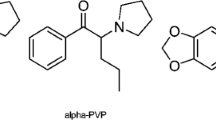Abstract
In a drug discrimination paradigm pigeons and rats were trained with an operant procedure to discriminate between the presence and absence of the effects of Δ9-THC (1.0 and 3.0 mg/kg, injected IM 90 min and I.P. 30 min before the start of the session). Once trained, various THC metabolites as well as a water-soluble derivative of THC (SP-111), were substituted for Δ9-THC to test for generalization to the training drug. Generalization to Δ9-THC occurred with the 11-hydroxy metabolites and the potency order was 11-OH-Δ9-THC >11-OH-Δ8-THC ⩾Δ9-THC. Among the other metabolites tested (8α-OH-Δ9-THC, 8α, 11-di-OH-Δ9-THC, 8β-OH-Δ9-THC, 8β, 11-di-OH-Δ9-THC), it was only 11-di-OH-Δ9-THC that completely substituted for Δ9-THC in pigeons, albeit at very high dose levels (rats were not tested with these metabolites). SP-111 generalized to Δ9-THC in both species. However, the onset of action of SP-111 was slower than that for Δ9-THC, especially in pigeons. These studies show the importance of obtaining complete dose-effect determinations over time when assessing structure-activity relationships with drug-discrimination procedures.
Similar content being viewed by others
References
Balster RL, Ford RD (1978) The discriminative stimulus properties of cannabinoids: a review. In: Ho BT, Richards DW III, Chute DL (eds) Drug discrimination and state dependent learning. Academic, New York, p 131
Barry H, III Krimmer EC (1976) Δ9-THC stimulus tested with several doses, routes, intervals and a marihuana extract. In: Braude MC, Szara S (eds) Pharmacology of marihuana. Raven, New York, p 535
Barry H, III, Kubena RK (1972) Discriminative stimulus characteristics of alcohol, marihuana and atropine. In: Singh JM, Miller L, Lal H (eds) Drug addiction: Experimental pharmacology. Futura, Mount Kisco, p 3
Bhargava HN (1978) Potential therapeutic applications of naturally occurring and synthetic cannabinoids. Gen Pharmacol 9:195–213
Bueno OFA, Carlini EA, Finkelfarb E, Suzuki JS (1976) Δ9-Tetrahydrocannabinol ethanol, and amphetamine as discriminative stimuli-generalization tests with other drugs. Psychopharmacologia 46:235–243
Colpaert FC, Niemeegers CJE, Janssen PAJ (1977) Differential haloperidol effect on two indices of fentanyl saline discrimination. Psychopharmacology 53:169–173
Colpaert FC, Rosecrans JA (eds) (1978) Stimulus properties of drugs. Elsevier/North-Holland, Amsterdam
Dykstra LA, McMillan DE, Harris LS (1975) Effects of Δ9-THC and a water soluble ester of Δ9-THC on schedule-controlled behavior. Pharmacol Biochem Behav 3:29–32
Henriksson BG, Johansson JO, Järbe TUC (1975) Δ9-Tetrahydrocannabinol produced discrimination in pigeons. Pharmac Biochem Behav 3:771–774
Hollister LE (1974) Structure-activity relationships in man of cannabis constituents, homologs and metabolites of Δ9-THC. Pharmacology 11:3–11
Järbe TUC, Henriksson BG (1974) Discriminative response control produced with hashish, tetrahydrocannabinols (Δ8-THC and Δ9-THC), and other drugs. Psychopharmacologia 40:1–16
Järbe TUC, Henriksson BG, Ohlin GC (1977) Δ9-THC as a discriminative cue in pigeons: effects of Δ8-THC, CBD, and CBN. Arch Int Pharmacodyn 228:68–72
Järbe TUC, Johansson JO, Henriksson BG (1976) Characteristics of tetrahydrocannabinol (THC)-produced discrimination in rats. Psychopharmacology 48:181–187
Järbe TUC, McMillan DE (1979) Discriminative stimulus properties of tetrahydrocannabinols and related drugs in rats and pigeons. Neuropharmacology 18:1023–1024
Järbe TUC, Ohlin GC (1979) Discriminative effects of combinations of Δ9-THC and pentobarbital in pigeons. Psychopharmacology 63:233–239
Lemberger L, Martz R, Rodda B, Forney R, Rowe H (1973) Comparative pharmacology of Δ9-tetrahydrocannabinol and its metabolite, 11-OH-Δ9-tetrahydrocannabinol. J Clin Invest 52:2411–2417
Litchfield JT, Wilcoxon F (1949) A simplified method for evaluating dose-effect experiments. J Pharmacol Exp Ther 96:99–113
McGuigan FJ (1968) Experimental psychology: A methodological approach. Prentice-Hall, Englewood Cliffs, p 176
McMillan DE (1977) Behavioral pharmacology of the tetrahydrocannabinols. In: Thompson T, Dews PB (eds) Advances in behavioral pharmacology. Academic, New York, p 1
Mechoulam R (1973) Cannabinoid chemistry. In: Mechoulam R (ed) Marijuana-chemistry, pharmacology, metabolism and clinical effects. Academic, London, p 1
Mechoulam R, McCallum NK, Lander N, Yagen B, Ben-Zvi Z, Levy S (1976) Aspects of cannabis chemistry and metabolism. In: Braude MC, Szara S (eds) Pharmacology of marihuana. Raven New York, p 39
Mechoulam R, Edery H (1973) Structure-activity relationships in the cannabinoid series. In: Mechoulam R (ed) Marijuana-chemistry, pharmacology, metabolism and clinical effects. Academic, London, p 101
Owen DB (1962) Handbook of statistical tables. Addison-Esley, Palo Alto, p 363
Pars HG, Razdan RK, Howes JF (1977) Potential therapeutic agents derived from the cannabinoid nucleus. In: Simmonds AB (ed) Advances in drug research, vol 11. Academic, London, p 97
Paton WDM, Pertwee RG (1973) The pharmacology of cannabis in animals. In: Mechoulam R (ed) Marijuana-chemistry, pharmacology, metabolism and clinical effects. Academic, London, p 191
Perez-Reyes M, Timmons MC, Lipton MA, Christensen HD, Davis KH, and Wall ME (1973) A comparison of the pharmacological activity of Δ9-tetrahydrocannabinol and its monohydroxylated metabolites in man. Experientia 29:1009–1010
Perez-Reyes M, Wagner D, Wall ME, Davis KH (1976) Intravenous administration of cannabinoids and intraocular pressure. In: Braude MC, Szara S (eds) Pharmacology of marihuana. Raven, New York, p 829
Schuster CR, Balster RL (1977) The Discriminative stimulus properties of drugs. In: Thompson T, Dews PB (eds) Advances in behavioral pharmacology. Academic, New York, p 85
Siegel S (1956) Nonparametric statistics. McGraw-Hill, New York, p 75
Weissman A (1978) Generalization of the discriminative stimulus properties of Δ9-tetrahydrocannabinol to cannabinoids with therapeutic potential. In: Colpaert FC, Rosecrans JA (eds) Stimulus properties of drugs: Ten years of progress. Elsevier/North Holland, Amsterdam, p 99
Zitko BA, Howes JA, Razdan RK, Dalzell BC, Dalzell HC, Sheehan JC, Pars HG, Dewey WL, Harris LS (1972) Water soluble derivatives of Δ1-tetrahydrocannabinol. Science 177:442–444
Author information
Authors and Affiliations
Rights and permissions
About this article
Cite this article
Järbe, T.U.C., McMillan, D.E. Δ9-THC as a discriminative stimulus in rats and pigeons: Generalization to THC metabolites and SP-111. Psychopharmacology 71, 281–289 (1980). https://doi.org/10.1007/BF00433063
Received:
Issue Date:
DOI: https://doi.org/10.1007/BF00433063




